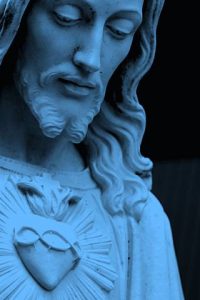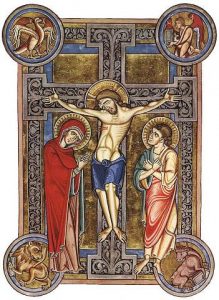The Journey of a Lifetime
An Orientation to the Catholic Spiritual Journey
In describing the Catholic Spiritual Journey lived over a lifetime (in the various maturity stages of life: childhood, youth, young adulthood, middle adulthood, and elder adulthood) we make this journey with the following directions and spiritual help:
On the journey we follow Christ.
On the journey we are given Direction for the journey
On the journey we need Food: nourishment for the soul.
On the journey we need Companions.
On the journey we need to Help any along the way who need our help.
We invite you to make this Catholic Spiritual Journey with us at Holy Faith. The following describes the journey in more detail, to help you to understand the mission.
Contents of this section:
[fruitful_tabs type=”default” width=”100%” fit=”false”]
[fruitful_tab title=”The Invitation to a Journey”]
The Invitation to a Journey in God’s Love
Each of us is on a journey and God intends it to be the “trip of a lifetime,” an adventure: the adventure we’ve always longed for. What does this mean?
The 5th Century saint, St. Augustine, wrote
“Our hearts were made for you, O God, and they are restless until they find their rest in You.”
(Confessions I,1) Much of this restlessness comes from sin, which is a turning away from God; sin is a refusal to love as God loves us. But God does love us and wants us to find “rest”, i.e fulfillment in life by living in his love without end.
“For God so loved the world, that He gave His only begotten Son, that whoever believes in Him shall not perish, but have eternal life. For God did not send the Son into the world to condemn the world, but that the world might be saved through Him.” (John 3:16-17)
 The Christian Message (called Good News, the Gospel) tells us that God’s Son took flesh and was born among us as the Savior Christ Jesus and it is he who leads us to our heart’s desire: the God who is love. (See 1 John 4:8b) Christ calls us to follow him on a journey which is the way of love: the divine, sacrificial love which leads us into God’s beauty, goodness, truth, justice (right relationships), peace, and joy.
The Christian Message (called Good News, the Gospel) tells us that God’s Son took flesh and was born among us as the Savior Christ Jesus and it is he who leads us to our heart’s desire: the God who is love. (See 1 John 4:8b) Christ calls us to follow him on a journey which is the way of love: the divine, sacrificial love which leads us into God’s beauty, goodness, truth, justice (right relationships), peace, and joy.
This love is a great challenging way to live because it must be lived in the face and opposition of the sin in this world, and that sin which we find in ourselves too often. In the face of this sin, Jesus showed God’s love and was nailed to a Cross. Yet after he died, he rose to a new, transformed human life, revealing that God’s love never ends and sin and death cannot defeat it.
On this journey of following Christ, we will need to die to sin (put it to death within ourselves by God’s power in us); we also rise with Christ to new life. This is the path and pattern of our lives, the Passover from death to life, called the Paschal Mystery. It happens over and over again, till the end of our lives. It is the way of love and it is a journey which involves everything we are, but is deeply meaningful and totally fulfilling.
We believe this is the adventure we have always longed for.
Read More About Following Christ
[/fruitful_tab]
[fruitful_tab title=”Life is a Journey”]
Life is a Journey
“Life is a highway, I wanna ride it All night long; If you’re going my way, I wanna drive it All night long” Tom Cochran
“Do you know where you’re going to? Do you like the things that life is showing you? Where are you going to? Do you know…?” Theme from Mahogany
Popular songs, like the ones quoted above, speak of life in terms of a journey; life is meant “to go somewhere.” We talk about progress, which literally means “moving forward; proceeding onward; advancing.” We might talk about “going the distance.” Sometimes in crisis and sometimes in quiet self-reflection, we may ask: “Where is my life heading? Where am I going?” It is important to answer that question, for as the saying goes: “If you don’t know where you are going, you’re lost.”
The image of life as a journey is a good image and the Bible records many journeys w ith God. The Christian message believes that God intends for our life to be “a journey of a lifetime.” This statement deliberately plays upon two meanings which can be given it: our lifetime is a journey, usually from childhood to old age; but also, God has a plan for our journey, a goal and destination, and it involves quite a bit of adventure in living the kind of life God calls us to live in his Son, Christ Jesus and the Holy Spirit.
ith God. The Christian message believes that God intends for our life to be “a journey of a lifetime.” This statement deliberately plays upon two meanings which can be given it: our lifetime is a journey, usually from childhood to old age; but also, God has a plan for our journey, a goal and destination, and it involves quite a bit of adventure in living the kind of life God calls us to live in his Son, Christ Jesus and the Holy Spirit.
[/fruitful_tab]
[fruitful_tab title=”Life is A Spiritual Journey”]
The Christian Life is A Spiritual Journey
By “Spiritual,” we Christians mean “of the Holy Spirit,” the Third Person of the Trinity: Father, Son, and Holy Spirit. As a Spiritual Journey, then, we mean life under the guidance and direction of the Holy Spirit. Every Christian is baptized into Christ, immersed into his life, and we receive his Holy Spirit, who guides, inspires, and animates our following Jesus.
The Holy Spirit is named by Jesus as the Helper (also translated “Comforter,” “Advocate,” “Counselor”; Jesus uses a Greek word which literally means “someone called to your side to help you” (see John 14:26). One way which I understand this Helper is that he is the “Best Friend” of the Son of God. This Spirit who is the divine “Best Friend” is always there with us, in time of need, and He gives us power to follow Jesus, to be faithful to God, and to live that divine love which “is poured into our hearts by the Spirit given to us.” (Romans 5:5)
We shall see many instances where the Spirit promised by Jesus to live within us will help us on our journey of a lifetime.
A note of caution: the term “spiritual” in our contemporary culture tends to be a “catch-all” term for all kinds of claims, some that border on the magical and superstitious (like New Age “spirituality”); it is best to avoid the “spirituality” sections of most secular bookstores. The term “spiritual” used in this website is always subject to Catholic teaching. I often capitalize the first letter of “Spiritual” to emphasize that we are talking about the Holy Spirit, often in relationship to the human spirit.
[/fruitful_tab]
[fruitful_tab title=”The Catholic Spiritual Life”]
The Catholic Spiritual Life

The Spiritual Journey being The Spiritual Journey being described on this website is one lived in union with the Roman Catholic Church, which means we belong to the original Christian Church founded by the Apostles, and particularly is under the leadership of the Church of Rome, headed by the Pope, the Bishop of Rome and the “Successor of the Apostle Peter.”
To belong to this Roman Catholic Church means we share the teachings of this Church in a visible communion with the Roman Catholic Bishops and the Pope, by sharing the worship and sacraments of this Church, and by living the life of Christ with one another in this Church.
There is, however, a deeper answer to the question “What does it mean to be Catholic?” Many books have been written to answer this question, because when compared to Protestant Christianity, there is indeed something different about the Catholic way of being Christian, though we share many of the same Christian teachings with our Protestant brothers and sisters.
A number of Catholic writers have asserted that “the Catholic thing” (that which is somewhat distinctive about the Catholic world view) is “a sacramental imagination,” also called “the sacramental approach.” This means that the images Catholics have of God, of the world, and of ourselves, are formed by a “Catholic vision that sees God in and through all things: other people, communities, movements, events, places, objects, the world at large, the whole cosmos. The visible, the tangible, the finite, the historical, all these are actual or potential carriers of the divine presence.” (Richard McBrien, Catholicism, p.1180)
Simply put, Catholicism is big on emphasizing that creation and human relationships are not only “used” by God to reveal God’s presence to us, but also, creation and human relationships are already graced by God as good, flawed only by sin. The Son of God who became flesh and lived among us, “one like us in all things except sin,” (see Hebrews 4:15) is the Supreme Image of this “sacramental principle.” (Colossians 1:15: “He [Christ Jesus] is the image of the invisible God, the firstborn of all creation.”)
To read more about the Catholic or Sacramental Imagination, click here.
[/fruitful_tab]
[fruitful_tab title=”The Destination”]
The Destination: Love Everlasting
It is important to know where we are going, to know what our destination is at the end of our journey, for the journey will end one day, when we die, and then where shall we find ourselves?
For the follower of Christ, we hope to share in his Resurrection and to live with him and with all the blessed ones in Heaven for ever after this life.
The Catechism teaches us: “Those who die in God’s grace and friendship and are perfectly purified live forever with Christ. They are like God for ever, for they ‘see him as he is,’ face to face.” (#1023)
“This perfect life with the Most Holy Trinity, this communion of life and love with the Trinity, with the Virgin Mary, the angels and all the blessed is called ‘heaven.’ Heaven is the ultimate end and fulfillment of the deepest human longings, the state of supreme, definitive happiness.” (#1024)
Then we will live a life which is the fulfillment of the life we began to live on earth, and which will one day be the transformed life of a new heaven and a new earth (See 2 Peter 3:13): and this will be the fulfilment of all love divine and human, all beauty, all goodness, all truth, all justice (right relationships), all peace, and all joy.
Until that day when we die, or the Lord Jesus returns again in glory, we are on this journey. We invite you to make it with us at Holy Faith, in the Holy Spirit and in the Catholic Way.

[/fruitful_tab]
[/fruitful_tabs]
